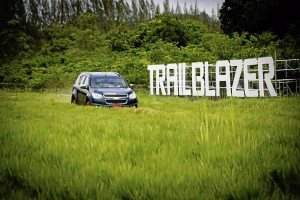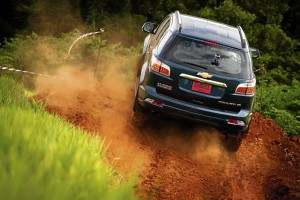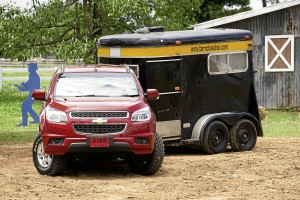
REMEMBER the name (and of course its features), that’s what the trail reminds any journalist given the chance to test-drive the Trailblazer.
It’s not exactly the most handsome brute on the block, but it sure could get the job done. That about summed up the all-new Chevrolet Trailblazer, the Detroit-based motor vehicle manufacturing company’s latest entry in the SUV-D category.
Scheduled for distribution in the Philippines in the last quarter of the year, the Trailblazer is going through the pre-sale work-ups, including a programmed two-day test drive for the media that started with a run through Bangkok central business district’s chaotic traffic rush, and then moving on to the wide open spaces of Thailand’s northern rugged farmlands.
Five Filipino journalists arrived for lunch at Camp Chokchai, a famous 40-hectare progressive agricultural enclave that breeds cattle and produces dairy products for the Thai market. Also at the expanse are rough roads and steep mountains trails that are worthy challenges to any decent farm vehicle.

THE TRAILBLAZER has an engine drag control that prevents the wheels from locking due to the braking effect of the engine on slippery surfaces.
The afternoon was reserved for the road tests. In a paddock, Chevrolet carved out a rough track to put the Trailblazer through some interesting paces-uneven deep trails that can tilt the cab 45 degrees, steep climbs of fresh slippery dirt, creek crossing, tall rough grasses and imbedded logs, and sharp turning contours on climbing and descending ground.
At any of the rough parts, the Trailblazer easily made it, thanks to its minimum ground clearance of 267 mm (255 mm if equipped with 16-inch wheels) and high approach and departure angles (31 degrees front, 26 degrees rear). Offsets from the roof to wheels are approximately 292 mm, showcasing the planted nature of the Trailblazer and an execution that is not “over-bodied.”
You could be misled into thinking just how great a driver you are until you get to know what the Trailblazer is all about. For starters, it has an engine drag control that prevents the driven wheels from locking due to the braking effect of the engine on slippery surfaces when the driver suddenly takes the foot off the accelerator or rapidly shifts down a gear.
If the control unit detects that the driven wheels are slipping, the engine-drag torque control system sends a signal to the engine control unit indicating that engine torque should be increased, until the driven wheels are once again turning at a rate proportionate to the speed of the vehicle.
The cornering brake control is activated when the vehicle brakes while cornering. Brake pressure is individually varied between all four wheels in order to keep the vehicle stable, minimizing tendencies to oversteer or understeer.
A hydraulic brake fade assist also automatically raises braking pressure to compensate for brake fade under repeated applications of heavy braking.
Hill ascents and descents
READY for rugged off-road conditions but equally well-mannered for city and long-distance road trips
Out of the test paddock to the adjacent hills, the Trailblazer was a smooth drive up and down the unpaved trails. The Duramax turbo-diesel engines primarily provide power to the rear wheels via a five-speed manual (2.5-L/2.8-L variant) or six-speed automatic transmission (2.8 L).
The six-speed automatic transmission comes with a driver shift control, allowing for more precise control of gear ratio selection by the driver. On four-wheel-drive versions, torque is split to the front wheels via a new, two-speed electronically actuated part-time transfer case.
The transfer case features 2-high (rear-wheel-drive only), 4-high, 4-low (with a ratio of 2.62) and neutral positions, all selectable via a rotary electronic switch at the bottom of the center console behind the gearshift. The transfer case can be shifted on-the-fly (without stopping the vehicle, from 2H to 4H only) and features dual-row input bearing for improved tolerance to shaft misalignment for smoother and quieter transitions.
The Trailblazer also has an impressive hill descent control that allows a smooth and controlled hill descent in rough terrain without the driver needing to touch the brake pedal.
Depression of a button on the console enables the vehicle to descend using the ABS to control each wheel’s speed. If the vehicle accelerates without driver input, the system will automatically apply the brakes to slow down to the desired vehicle speed.
On the other hand, the hill start assist prevents the vehicle from rolling backwards when trying to pull away on an uphill gradient, simulating a “handbrake hill start” manual-transmission that drivers are familiar with.
The system engages automatically when a gradient of three percent or more is detected, and acts to hold the vehicle stationary for two seconds after the brake is released to give the driver time to apply throttle.
Towing power
And finally, to demonstrate just how much pulling power the Trailblazer had, we were asked to maneuver the vehicle with a horse-cart in tow. With its body-on-frame (BOF) architecture, the vehicle takes on the toughness and durability of a truck, while providing for better refinement and enhanced interior space.
A BOF construction also allows the Trailblazer to have a towing capacity of up to 3,000 kg (for the 2.8L variant) while the 2.5L variant can tow up to 2,500 kg-definitely something that your ordinary SUV with a monocoque architecture can do.
A BOF construction also allows for better off-road capability and durability by virtue of the architecture’s tougher quality.
According to Martin Apfel, president of GM Southeast Asia, the Trailblazer was developed in tandem with the all-new Chevrolet Colorado midsize pickup truck by a highly skilled team of GM engineers, who used their expertise to add passenger vehicle attributes to the midsize truck architecture.
“The Trailblazer is strong and capable. Ready for rugged off-road conditions but equally well-mannered for city and long distance road trips. It will be built in Thailand, and soon also make its way into the rest of the world. It is yet another world-class Chevrolet product that demonstrates the capability, commitment and attention to detail of our dedicated Thai workforce,” Apfel said.
“True to its name, the Trailblazer will blaze the trail for new Chevrolet vehicles coming into the market. It has been built tough to offer Chevrolet customers everything they need from a heavy-duty SUV,” he added.
On the trail
Before production of the Trailblazer started, it was tested and validated on some of the best highways, in addition to the poorest road conditions and toughest terrain, around the world.
While a large portion of testing and validation was done in Brazil, the Trailblazer was also tested and validated in Thailand to enhance the SUV’s suitability in Asia. Clearly, the Trailblazer has been developed as much for Thailand and the Southeast Asian region as it has been for the rest of the world.
Pricing, colors and trim levels of the Trailblazer will be announced closer to the launch of the vehicle in the Philippines, according to Lyn Buena, senior vice president and director for marketing and customer services division of Chevrolet Philippines-The Covenant Car Co. Inc. The vehicle is expected to be positioned against market leaders Mitsubishi’s Montero and Toyota’s Fortuner. Well, talk of some tough test.


